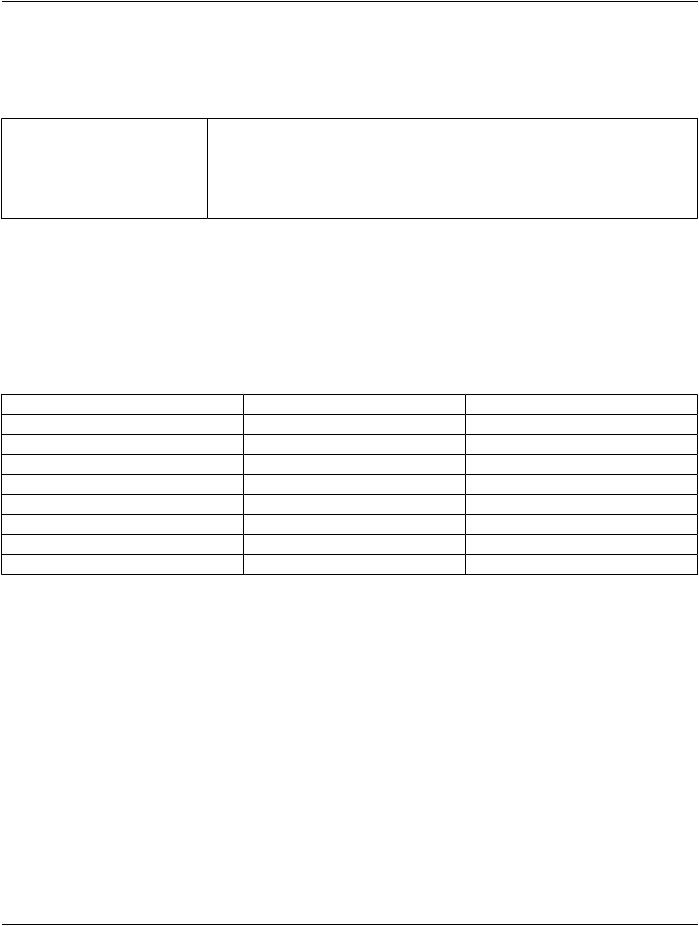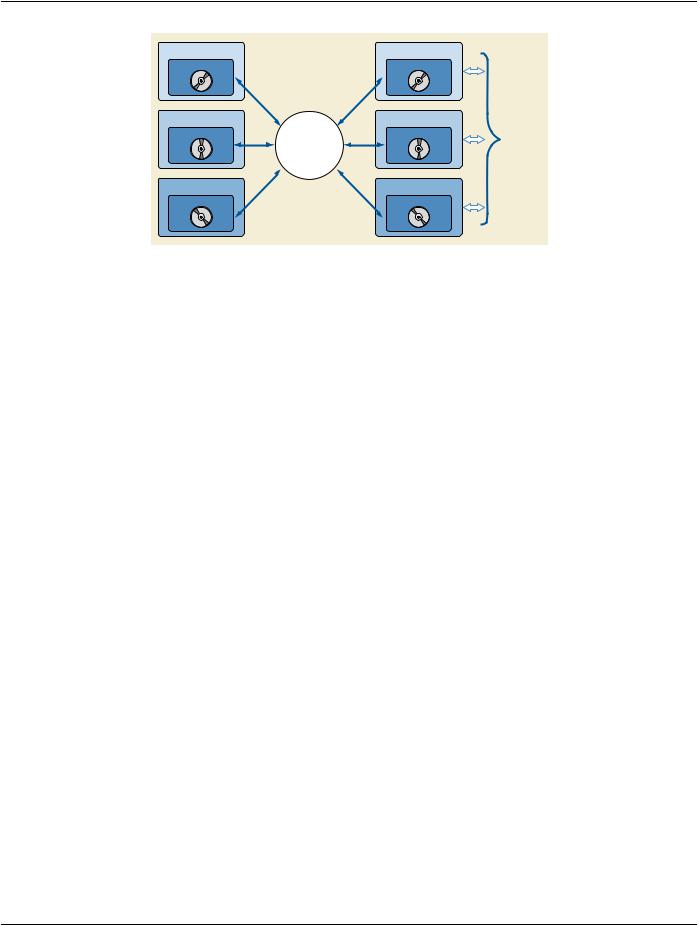
PS-2020a / part11
.pdf
DICOM PS3.11 2020a - Media Storage Application Profiles |
Page 41 |
B.3.4.1 Image Attribute Values
The attributes listed in Table B.3-3 used within the X-Ray Angiographic Image files have the specified values.
Table B.3-3. STD-XA1K Required XA Image Attribute Values
Attribute |
Tag |
Value |
Modality |
(0008,0060) |
XA |
Rows |
(0028,0010) |
up to 1024 (see below) |
Columns |
(0028,0011) |
up to 1024 (see below) |
Bits Stored |
(0028,0101) |
8, 10, and 12 bits only |
Note
1.An FSC or FSU, when creating or updating a File-set, Rows or Columns will not exceed a value of 1024. When reading a File-set, an FSR or FSU will accept all values of up to 1024 for Rows or Columns.
2.Photometric Interpretation, Pixel Representation, High Bit, Bits Allocated and Samples per Pixel are defined in the XA IOD.
The attributes listed in Table B.3-4 used within the Secondary Capture Image files have the specified values.
Table B.3-4. STD-XA1K Required SC Image Attribute Values
Attribute |
Tag |
Value |
Rows |
(0028,0010) |
up to 1024 (see below) |
Columns |
(0028,0011) |
up to 1024 (see below) |
Samples per Pixel |
(0028,0002) |
1 |
Photometric Interpretation |
(0028,0004) |
MONOCHROME2 |
Bits Allocated |
(0028,0100) |
8 bits only |
Bits Stored |
(0028,0101) |
8 bits only |
High Bit |
(0028,0102) |
7 |
Pixel Representation |
(0028,0103) |
0000H (unsigned) |
Note
1.An FSC or FSU, when creating or updating a File-set, Rows or Columns will not exceed a value of 1024. When reading a File-set, an FSR or FSU will accept all values of up to 1024 for Rows or Columns.
2.It is recommend that Referenced Image Sequence (0008,1140) be present if the SC Image is significantly related to XA images and frames stored on the same media, and if present, it should contain references to those images and frames.
Overlay Group 60XX shall not be present in Secondary Capture Images, and Standalone Overlays shall not be referenced by or to Secondary Capture Images used in this profile.
B.3.4.2 Multi-frame JPEG Format
The JPEG encoding of pixel data shall use Interchange Format (with table specification) for all frames.
B.3.4.3 Attribute Value Precedence
Retired.
- Standard -

Page 42 |
DICOM PS3.11 2020a - Media Storage Application Profiles |
- Standard -

DICOM PS3.11 2020a - Media Storage Application Profiles |
Page 43 |
CUltrasoundApplicationProfile(Normative)
C.1 Class and Profile Identification
This Annex defines Application Profiles for Ultrasound Media Storage applications. Each Application Profile has a unique identifier used for conformance claims. Due to the variety of clinical applications of storage media in Ultrasound, a family of application profiles are described in this section to best tailor an application choice to the specific needs of the user. The identifier used to describe each profile is broken down into three parts: a prefix, mid-section, and suffix. The prefix describes the overall Application Profile Class and is common for all ultrasound application profiles. The mid section describes the specific clinical application of the profile. The suffix is used to describe the actual media choice the profile will use.
The prefix for this class of application profiles is identified with the STD-US identifier.
Note
Conformance Statements may use the earlier prefix of APL that is equivalent to STD. This use is deprecated and may be retired in future editions of the Standard.
The midsection is broken down into three subclasses that describe the clinical use of the data. These subclasses are: Image Display (ID identifier), Spatial Calibration (SC identifier), and Combined Calibration (CC identifier). All three subclasses can be applied to either single frames (SF) images or single and multi-frames (MF) images. The SC subclass enhances the ID class by adding the re- quirement for region specific spatial calibration data with each IOD. The CC subclass enhances the SC subclass by requiring region specific pixel component calibration.
The suffix, xxxx, is used to describe the actual media choice used for the conformance claim. Any of the above mentioned classes can be stored onto one of eight pieces of media described in the Table C.3-3.
The specific Application Profiles are shown in the following table.
Table C.1-1. Ultrasound Application Profile identifiers
Application Profile |
Single Frame |
Single & Multi-Frame |
Image Display |
STD-US-ID-SF-xxxx |
STD-US-ID-MF-xxxx |
Spatial Calibration |
STD-US-SC-SF-xxxx |
STD-US-SC-MF-xxxx |
Combined Calibration |
STD-US-CC-SF-xxxx |
STD-US-CC-MF-xxxx |
The ID Application Profile Classes are intended to be used for the transfer of ultrasound images for display purposes.
The SC Application Profile Classes are intended to be used for the transfer of ultrasound images with spatial calibration data for quantitative purposes (see Section C.4).
The CC Application Profile Classes are intended to be used for the transfer of ultrasound images with spatial and pixel component calibration data for more advanced quantitative purposes (see Section C.5).
C.2 Clinical Context
These classes of Application Profiles facilitate the interchange of ultrasound data on media. Typical interchanges would be between ultrasoundsystems,betweenanultrasoundsystemandadisplayworkstation,betweendisplayworkstations,orbetweenanultrasound system and a data archive. This context is shown in Figure C.2-1.
- Standard -

Page 44 |
DICOM PS3.11 2020a - Media Storage Application Profiles |
Ultrasound System |
Ultrasound System |
|
Removable Media |
Removable Media |
|
Workstation |
Workstation |
Possible |
Domain of |
Removable Media |
Network |
Removable Media |
for |
|
DICOM |
|
|
Media Data |
|
DICOM |
Interchange |
|
Network |
|
|
Interchange |
Archive |
Archive |
|
Removable Media |
Removable Media |
|
Figure C.2-1. Ultrasound Clinical Context
The operational use of the media transfer is potentially both intra-institutional and inter-institutional.
C.2.1 Roles
C.2.1.1 File Set Creator
The role of File Set Creator shall be used by Application Entities that generate a File Set under the STD-US class of Application Profiles. Typical entities using this role would include ultrasound imaging equipment, workstations, and archive systems that generate apatientrecordfortransfer.FileSetCreatorsshallbeabletogeneratetheDICOMDIRdirectoryfile,singleand/ormultiframeUltrasound Information Object files, and depending on the subclass, region specific calibration in the defined Transfer Syntaxes.
An FSC shall offer the ability to either finalize the disc at the completion of the most recent write session (no additional information can be subsequently added to the disc) or to allow multi-session (additional information may be subsequently added to the disc) or to allow packet-writing, if supported by the media and file system specified in the profile.
C.2.1.2 File Set Reader
The role of File Set Reader shall be used by Application Entities that receive a transferred File Set. Typical entities using this role would include ultrasound systems, display workstations, and archive systems that receive a patient record from a piece of media. File Set Readers shall be able to read the DICOMDIR directory file and all Information Objects defined for the specific Application Profiles, using the defined Transfer Syntaxes.
C.2.1.3 File Set Updater
The role of File Set Updater shall be used by Application Entities that receive a transferred File Set and updates it by the addition or deletion of objects to the media. Typical entities using this role would include ultrasound systems adding new patient records to the media and workstations that may add an information object containing a processed or modified image.
An FSU shall offer the ability to either finalize the disc at the completion of the most recent write session (no additional information can be subsequently added to the disc) or to allow multi-session (additional information may be subsequently added to the disc) or to allow packet-writing, if supported by the media and file system specified in the profile.
The FSU role is not defined for the STD-US-xx-xx-DVD profiles (i.e., for DVD media that is not DVD-RAM).
C.3 General Class Profile
C.3.1 Abstract and Transfer Syntaxes
Application Profiles in this class, STD-US, shall support the appropriate Information Object Definitions (IOD) and Transfer Syntaxes for the Media Storage SOP Class in the following table. In the role of FS-Updater or FS-Creator the application can choose one of
- Standard -

DICOM PS3.11 2020a - Media Storage Application Profiles |
Page 45 |
the three possible transfer Syntaxes to create an IOD. In the role of FS-Reader an application shall support all transfer Syntaxes defined for the STD-US application profile.
Table C.3-1. Ultrasound SOP Classes and Transfer Syntaxes
Information Object Definition |
SOP Class UID |
Transfer Syntax |
Transfer Syntax UID |
|
DICOM Media Storage Directory1.2.840.10008.1.3.10 |
Explicit VR Little Endian |
1.2.840.10008.1.2.1 (see |
||
|
|
|
Uncompressed |
Section 8.6 in PS3.10) |
Ultrasound Image Storage |
1.2.840.10008.5.1.4.1.1.6.1Explicit VR Little Endian |
1.2.840.10008.1.2.1 |
||
|
|
|
Uncompressed |
|
Ultrasound Image Storage |
1.2.840.10008.5.1.4.1.1.6.1RLE Lossless Image Compression |
1.2.840.10008.1.2.5 |
||
Ultrasound Image Storage |
1.2.840.10008.5.1.4.1.1.6.1JPEGLossy,BaselineSequentialwith1.2.840.10008.1.2.4.50 |
|||
|
|
|
Huffman Coding (Process 1) |
|
Ultrasound Multi-frame Image |
1.2.840.10008.5.1.4.1.1.3.1Explicit VR Little Endian |
1.2.840.10008.1.2.1 |
||
Storage |
|
|
Uncompressed |
|
Ultrasound Multi-frame Image |
1.2.840.10008.5.1.4.1.1.3.1RLE Lossless Image Compression |
1.2.840.10008.1.2.5 |
||
Storage |
|
|
|
|
Ultrasound Multi-frame Image |
1.2.840.10008.5.1.4.1.1.3.1JPEGLossy,BaselineSequentialwith1.2.840.10008.1.2.4.50 |
|||
Storage |
|
|
Huffman Coding (Process 1) |
|
C.3.1.1 Ultrasound Single and Multi-frame Pixel Formats Supported
The STD-US application profile requires that all ultrasound image objects only be stored using the values described in PS3.3 US Image Module and the specializations used for the Ultrasound Single and Multi-Frame IODs.
In the role of FS-Updater or FS-Creator the application can choose any of the supported Photometric Interpretations described in PS3.3USImageModuletocreateanIOD.IntheroleofFS-Reader,anapplicationshallsupportallPhotometricInterpretationsdescribed in PS3.3 US Image Module.
Table C.3-2 describes restrictions on the use of various Transfer Syntaxes with the supported Photometric Interpretations for both single and multi-frame images.
Table C.3-2. Defined Photometric Interpretation and Transfer Syntax Pairs
Photometric Interpretation |
Transfer Syntax |
Transfer Syntax UID |
Value |
|
|
MONOCHROME2 |
Uncompressed |
1.2.840.10008.1.2.1 |
|
RLE Lossless Image Compression |
1.2.840.10008.1.2.5 |
RGB |
Uncompressed |
1.2.840.10008.1.2.1 |
|
RLE Lossless Image Compression |
1.2.840.10008.1.2.5 |
PALETTE COLOR |
Uncompressed |
1.2.840.10008.1.2.1 |
|
RLE Lossless Image Compression |
1.2.840.10008.1.2.5 |
YBR_FULL |
RLE Lossless Image Compression |
1.2.840.10008.1.2.5 |
YBR_FULL_422 |
Uncompressed |
1.2.840.10008.1.2.1 |
|
JPEG Lossy |
1.2.840.10008.1.2.4.50 |
C.3.2 Physical Media and Media Formats
An ultrasound application profile class may be supported by any one of the media described in Table C.3-3.
- Standard -

Page 46 DICOM PS3.11 2020a - Media Storage Application Profiles
Table C.3-3. Media Classes
Media |
Media Classes |
Media Format |
PS3.12 |
2.3GB 90mm MOD |
MOD23-90 |
DOS, unpartitioned (removableAnnex Q “90 mm 2.3 GB Magneto-Optical Disk |
|
|
|
media) |
(Normative)” |
CD-R |
CDR |
ISO/IEC 9660 |
Annex F “120mm CD-R Medium (Normative)” |
DVD-RAM |
DVD-RAM |
UDF1.5 |
Annex J “UDF on 120 mm DVD-RAM Medium |
|
|
|
(Normative)” |
120 mm DVD |
DVD |
UDF or ISO 9660 |
Annex P “120 mm DVD Medium (Normative)” |
Note
Media Classes FLOP, MOD128, MOD230, MOD540, MOD640, MOD650, MOD12 AND MOD23 were previously defined but have been retired. See PS3.11 2004.
C.3.3 DICOMDIR
The Directory shall include Directory Records of PATIENT, STUDY, SERIES, IMAGE corresponding to the information object files in the File Set. All DICOM files in the File Set incorporating SOP Instances (Information Objects) defined for the specific Application Profile shall be referenced by Directory Records. At the image level each file contains a single ultrasound image object or a single ultrasound multi-frame image object as defined in PS3.3 of the Standard.
Note
For all media selected in this Application Profile Class, STD-US, the following applies as defined in PS3.12.
All implementations should include the DICOM Media Storage Directory in the DICOMDIR file. There should only be one DICOMDIR file on a single media. The DICOMDIR file should be found in the root directory of the media. For the case of double-sided MOD media, there shall be a DICOMDIR on each side of the media.
On a single media the patient ID key at the patient level shall be unique for each patient directory record.
C.3.3.1 Additional Keys
File Set Creators and Updaters are only required to generate mandatory elements specified in PS3.10. At each directory record level any additional data elements can be added as keys, but is not required by File Set Readers to be able to use them as keys.
C.3.3.2 File Component IDs
Note
FileComponentIDsshouldbecreatedusingarandomnumberfilenametominimizeFileComponentIDcollisionsasdescribed in PS3.12. The FS-Updater should check the existence of a Component ID prior to creating that ID. Should an ID collision occur, the FS-Updater should try another ID.
C.4 Spatial Calibration (SC) Class Requirements
All implementations conforming to the Application Profile Class SC shall include the US Region Calibration Module with the exception of pixel component organization data element (0018,6044) and other data elements that are conditional on that data element.
C.5 Combined Calibration (CC) Class Requirements
All implementations conforming to the Application Profile Class CC shall include the US Region Calibration Module including the pixel component organization data element (0018,6044) and other data elements that are conditional on that data element.
- Standard -

DICOM PS3.11 2020a - Media Storage Application Profiles |
Page 47 |
D General Purpose CD-R, DVD and BD
Interchange Profiles (Normative)
D.1 Profile Identification
This Annex defines an Application Profile Class potentially inclusive of all defined Media Storage SOP Classes. This class is intended to be used for the interchange of Composite SOP Instances via CD-R, DVD-RAM and BD media for general purpose applications. Objects from multiple modalities may be included on the same media.
A detailed list of the Media Storage SOP Classes that may be supported is defined in PS3.4.
Table D.1-1. STD-GEN Profile
Application Profile |
Identifier |
Description |
GeneralPurposeCD-RInterchangeSTD-GEN-CD |
HandlesinterchangeofCompositeSOPInstancessuchasImages, |
|
|
|
Structured Reports, Presentation States and Waveforms. |
General Purpose Interchange on STD-GEN-DVD-RAM |
HandlesinterchangeofCompositeSOPInstancessuchasImages, |
|
DVD-RAM Media |
|
Structured Reports, Presentation States and Waveforms. |
General Purpose Secure CD-R |
STD-GEN-SEC-CD |
HandlesinterchangeofCompositeSOPInstancessuchasImages, |
Interchange |
|
Structured Reports, Presentation States and Waveforms. Offers |
|
|
confidentiality, integrity and, depending on the File-set creator's |
|
|
choice, data origin authentication. |
General Purpose Secure |
STD-GEN-SEC-DVD-RAMHandlesinterchangeofCompositeSOPInstancessuchasImages, |
|
Interchange on DVD-RAM Media |
|
Structured Reports, Presentation States and Waveforms. Offers |
|
|
confidentiality, integrity and, depending on the File-set creator's |
|
|
choice, data origin authentication. |
General Purpose Interchange on STD-GEN-BD |
HandlesInterchangeofCompositeSOPInstancessuchasImages, |
|
BD Media |
|
Structured Reports, Presentation States and Waveforms. |
General Purpose Secure |
STD-GEN-SEC-BD |
HandlesInterchangeofCompositeSOPInstancessuchasImages, |
Interchange on BD Media |
|
Structured Reports, Presentation States and Waveforms. Offers |
|
|
confidentiality, integrity and, depending on the File-set creator's |
|
|
choice, data origin authentication. |
The identifier for this General Purpose Image Exchange profile class shall be STD-GEN.
Equipment claiming conformance to this Application Profile shall list the subset of Media Storage SOP Classes that it supports in its Conformance Statement.
Note
Since it is not required to support all Media Storage Classes the user should carefully consider the subset of supported Media Storage SOP Classes in the Conformance Statements of such equipment to establish effective object interchange.
D.2 Clinical Context
ThisApplicationProfilefacilitatestheinterchangeofimagesandrelateddataonCD-R,DVD-RAMandBDmedia.Typicalinterchange would be between acquisition devices, archives and workstations.
This Application Profile facilitates the creation of a multi-modality medium for image interchange, useful for clinical, patient record, teaching and research applications, within and between institutions.
This profile is intended only for general purpose applications. It is not intended as a replacement for specific Application Profiles that may be defined for a particular clinical context. The latter may support compression Transfer Syntaxes, limitations on the form and content of SOP Class instances, and specific media choices that preclude the use of the General Purpose Interchange Profile.
- Standard -

Page 48 |
DICOM PS3.11 2020a - Media Storage Application Profiles |
Note
The creation of a CD, DVD-RAM or BD is considerably more complex than the reading thereof. Therefore the clinical context for this Application profile is likely to be asymmetric, with a sophisticated File Set Creator and relatively simple File Set Readers.
D.2.1 Roles and Service Class Options
This Application Profile uses the Media Storage Service Class defined in PS3.4.
The Application Entity shall support one or more of the roles of File Set Creator (FSC), File Set Reader (FSR), and File Set Updater (FSU), defined in PS3.10.
D.2.1.1 File Set Creator
The role of File Set Creator shall be used by Application Entities that generate a File Set under this Image Interchange Class of Ap- plication Profiles.
FileSetCreatorsshallbeabletogeneratetheBasicDirectorySOPClassintheDICOMDIRfilewithallthesubsidiaryDirectoryRecords related to the Image SOP Classes stored in the File Set. The Application Entity acting as a File Set Creator generates a File Set under a STD-GEN Application Profile.
FSCshalloffertheabilitytoeitherfinalizethephysicalvolumeatthecompletionofthemostrecentwritesession(noadditionalinform- ation can be subsequently added to the volume) or to allow multi-session (additional information may be subsequently added to the volume) or to allow packet-writing, if supported by the media and file system specified in the profile.
Note
A multiple volume (i.e., a logical volume that can cross multiple physical media) is not supported by this class of Application profile. If a set of Files, e.g., a Study, cannot be written entirely on one physical volume (side of one piece of media), the FSC will create multiple independent DICOM File Sets such that each File Set can reside on a single physical volume (side of a single piece of media) controlled by its individual DICOMDIR file. The user of the FSC can opt to use written labels on the physical volumes to indicate that there is more than one physical volume for this set of files (e.g., a study).
D.2.1.2 File Set Reader
The role of File Set Reader shall be used by Application Entities that receive a transferred File Set under the Image Interchange Class of Application Profiles. Typical entities using this role would include image generating systems, display workstations, and archive systems that receive a patient record; e.g., transferred from another institution.
File Set Readers shall be able to read the DICOMDIR directory file and all the SOP Instance files defined for this Application Profile, for which a Conformance Statement is made, using the defined Transfer Syntax.
D.2.1.3 File Set Updater
The role of File Set Updater is used by Application Entities that receive a transferred File Set under the Image Exchange Class of Application Profiles and update it by the addition (or deletion) of images or information to (or from) the medium. Typical entities using this role would include image generating systems and workstations that process or modify images.
File Set Updaters shall be able to generate one or more of the SOP Instances defined for this Application Profile, for which a Conform- ance Statement is made, and to read and update the DICOMDIR file.
FSUshalloffertheabilitytoeitherfinalizethephysicalvolumeatthecompletionofthemostrecentwritesession(noadditionalinform- ation can be subsequently added to the volume) or to allow multi-session (additional information may be subsequently added to the volume) or to allow packet-writing. if supported by the media and file system specified in the profile.
Note
If the volume has not been finalized, the File Set Updater will be able to update information assuming there is enough space onthevolumetowriteanewDICOMDIRfile,theinformation,andthefundamentalvolumecontrolstructures.Volumecontrol structures are the structures that are inherent to the standards of the physical volume, see PS3.12.
- Standard -

DICOM PS3.11 2020a - Media Storage Application Profiles |
Page 49 |
D.3 STD-GEN Profile Class
D.3.1 SOP Classes and Transfer Syntaxes
This Application Profile is based on the Media Storage Service Class (see PS3.4).
Table D.3-1. STD-GEN SOP Classes and Transfer Syntaxes
Information Object SOP Class UID |
Transfer Syntax and UIDFSC RequirementFSR Requirement FSU |
||||
Definition |
|
|
|
|
Requirement |
Basic Directory |
1.2.840.10008.1.3.10Explicit VR Little Endian |
Mandatory |
Mandatory |
Mandatory |
|
|
|
Uncompressed |
|
|
|
|
|
1.2.840.10008.1.2.1 |
|
|
|
Composite Image & See PS3.4 |
Explicit VR Little Endian |
Defined in |
Defined in |
Optional |
|
Stand-alone Storage |
|
Uncompressed |
Conformance |
Conformance |
|
|
|
1.2.840.10008.1.2.1 |
Statement |
Statement |
|
|
|
|
|
|
|
The SOP Classes and corresponding Transfer Syntax supported by this Application Profile are specified in the Table D.3-1. The supported Storage SOP Class(es) shall be listed in the Conformance Statement using a table of the same form.
D.3.2 Physical Medium and Medium Format
The STD-GEN-CD and STD-GEN-SEC-CD application profiles require the 120 mm CD-R physical medium with the ISO/IEC 9660 Media Format, as defined in PS3.12.
The STD-GEN-DVD-RAM and STD-GEN-SEC-DVD-RAM application profiles require the 120 mm DVD-RAM medium, as defined in PS3.12.
The STD-GEN-BD and STD-GEN-SEC-BD application profiles require any of the 120 mm BD media, as defined in PS3.12.
D.3.3 Directory Information in DICOMDIR
ConformantApplicationEntitiesshallincludeintheDICOMDIRFiletheBasicDirectoryIODcontainingDirectoryRecordsatthePatient and the subsidiary Study and Series levels, appropriate to the SOP Classes in the File Set.
All DICOM files in the File Set incorporating SOP Instances defined for the specific Application Profile shall be referenced by Directory
Records.
Note
DICOMDIRs with no directory information are not allowed by this Application Profile.
All implementations shall include the DICOM Media Storage Directory in the DICOMDIR file. There shall only be one DICOMDIR file per File Set. The DICOMDIR file shall be in the root directory of the medium. The Patient ID at the patient level shall be unique for each patient directory record in one File Set.
D.3.3.1 Additional Keys
File Set Creators and Updaters are required to generate the mandatory elements specified in PS3.3.
Table D.3-2 specifies the additional associated keys. At each directory record level other additional data elements can be added, but it is not required that File Set Readers be able to use them as keys. Refer to the Basic Directory IOD in PS3.3.
- Standard -

Page 50 DICOM PS3.11 2020a - Media Storage Application Profiles
Table D.3-2. STD-GEN Additional DICOMDIR Keys
Key Attribute |
Tag |
Directory Record |
Type |
Notes |
|
|
Type |
|
|
Image Type |
(0008,0008) |
IMAGE |
1C |
Required if present in image object. |
Referenced Image Sequence |
(0008,1140) |
IMAGE |
1C |
Required if present in image object. |
>Referenced SOP Class UID |
(0008,1150) |
IMAGE |
1C |
Required if Referenced Image |
|
|
|
|
Sequence (0008,1140) is present |
>Referenced SOP Instance UID |
(0008,1155) |
IMAGE |
1C |
Required if Referenced Image |
|
|
|
|
Sequence (0008,1140) is present. |
>All other elements from Referenced Image Sequence |
IMAGE |
3 |
|
|
(including Purpose of Reference Code Sequence and its |
|
|
|
|
content) |
|
|
|
|
Note
The requirements with respect to the mandatory DICOMDIR keys in PS3.3 imply that either these attributes are present in the Image IOD, or they are in some other way supplied by the File-set Creator. These attributes are (0010,0020) Patient ID, (0008,0020) Study Date, (0008,0030) Study Time, (0020,0010) Study ID, (0020,0011) Series Number, and (0020,0013) In- stance Number.
D.3.3.2 Attribute Value Precedence
Retired. See PS3.11 2004.
Note
The retired Detached Patient Management SOP Class was previously suggested to allow patient identification and demo- graphic information to be updated without changing the composite Image IOD files. This usage is now retired.
D.3.4 Other Parameters
Not applicable.
D.3.5 Security Parameters
The STD-GEN-SEC-CD, STD-GEN-SEC-DVD-RAM and STD-GEN-SEC-BD application profiles require that all DICOM Files in the File-set including the DICOMDIR be Secure DICOM Files encapsulated in accordance with the requirements of the Basic DICOM Media Security Profile as defined in PS3.15.
Note
These Application Profiles do not place any consistency restrictions on the use of the Basic DICOM Media Security Profile withdifferentDICOMFilesofoneFile-set.Forexample,readersshouldnotassumethatallFilesintheFile-setcanbedecoded by the same set of recipients. Readers should also not assume that all secure Files use the same approach (hash key or digital signature) to ensure Integrity or carry the same originators' signatures.
- Standard -
